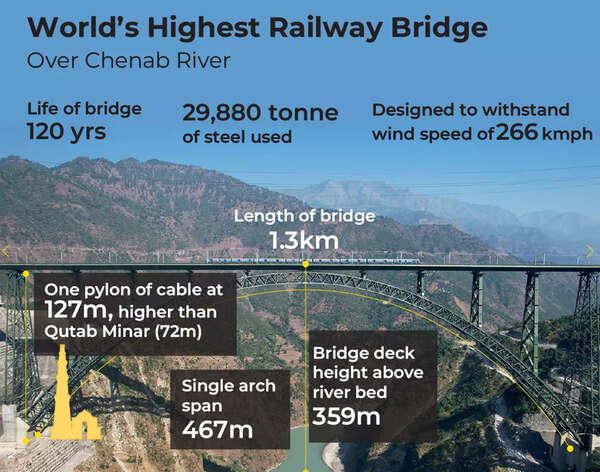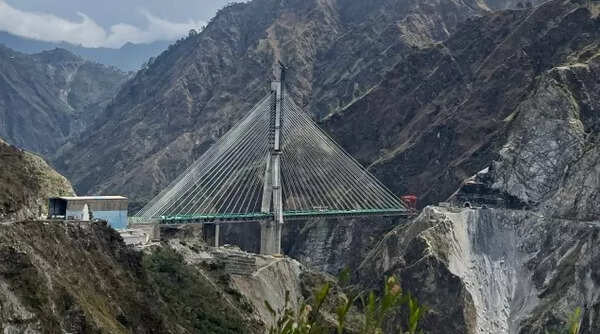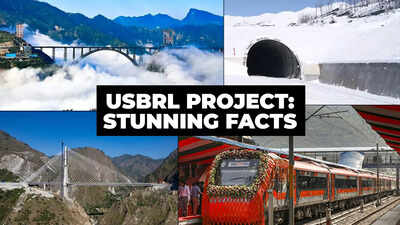USBRL, Chenab bridge inauguration: Prime Minister Narendra Modi has inaugurated a key section of the Udhampur–Srinagar–Baramulla Rail Link (USBRL) project in Jammu & Kashmir. With today’s inauguration, Kashmir has finally been connected to the rest of India by an all-weather Indian Railways line.Notably, the Chenab bridge, which is the world’s highest railway arch bridge, has also been thrown open to railway traffic as part of the inauguration. Also, this stretch also has the Anji Khad bridge, which is Indian Railways’ first cable-stayed bridge.PM Modi flagged off two Vande Bharat Express train services between Katra and Srinagar. These trains will connect Shri Mata Vaishno Devi Katra and Srinagar railway stations through the Chenab bridge. The entire USBRL project is seen as an engineering marvel, built over several years, in the challenging Himalayan terrain.
USBRL Rail Project With Chenab, Anji Bridges & Vande Bharat Trains: Top Facts
1. The Udhampur–Srinagar–Baramulla Rail Link (USBRL) stands as one of independent India’s most significant railway endeavours. This remarkable 272-kilometre railway network, constructed at ₹43,780 crore, traverses the challenging Himalayan terrain.2. The Indian Railways project has 36 tunnels extending across 119 kilometres, alongside 943 bridges that connect various valleys, ridges and mountain passes.3. This engineering achievement links isolated regions in Kashmir to the Indian Railways system, whilst fostering enhanced connectivity, commerce and tourism opportunities throughout Jammu and Kashmir.4. To enhance the rail connectivity’s effectiveness, a specially designed Vande Bharat Express service now operates between Katra and Srinagar.5. This particular train variant stands apart due to its specific adaptations for severe Himalayan winter conditions. It maintains efficient operations even when temperatures plunge to minus 20 degrees Celsius.6. The train’s specialised features, including heated windshields, sophisticated heating mechanisms and insulated toilet facilities, ensure year-round operations whilst maintaining passenger comfort.7. A dedicated snow clearance train will operate on this route to maintain uninterrupted services throughout the year.8. The installation of seismic dampers helps reduce vibrations and enhances passenger safety whilst travelling through this earthquake-prone region.9. The Chenab Rail Bridge, an extraordinary engineering achievement, reaches a height of 359 metres from the riverbed, claiming its position as the world’s highest railway arch bridge. This remarkable structure surpasses the Eiffel Tower by 35 metres in height. The Chenab bridge, stretching 1,315 metres, represents a crucial component of the Udhampur Srinagar Baramulla Railway Link.

Chenab Bridge Facts
10. Engineered for resilience in challenging landscapes and severe weather conditions, the Chenab bridge demonstrates exceptional durability with its capacity to resist winds reaching 260 kilometres per hour and a projected lifespan of 120 years.11. Built at a cost of ₹1,486 crore, Chenab bridge showcases India’s engineering excellence. The construction incorporates specialised structural steel that functions effectively between minus 10 to 40 degrees Celsius, ensuring consistent performance throughout temperature variations.12. The steel welding utilised in the project exceeds 600 kilometres in length, surpassing the distance of the railway track from Jammu to Delhi.13. The advanced ‘Tekla’ software used for the Chena bridge facilitated precise structural detailing, guaranteeing accuracy in both design and construction phases.14. The introduction of Vande Bharat Express service across Chenab bridge will substantially decrease the journey duration between Katra and Srinagar to approximately three hours, offering a reduction of two to three hours from the current travel time.15. USBRL also has India’s longest transportation tunnel, T50, which spans 12.77 kilometres between Khari and Sumber in Jammu and Kashmir. The tunnel serves as a crucial connection, establishing continuous railway access between the Kashmir Valley and mainland India.16. The tunnel’s construction made use of the New Austrian Tunnelling Method, navigating through diverse geological formations comprising quartzite, gneiss and phyllite. The construction process encountered significant challenges, including substantial water seepage, ground instability, shear zones and fractured volcanic rock structures.17. The T50 tunnel has comprehensive surveillance through CCTV cameras positioned at 50-metre intervals. A central monitoring facility oversees all camera feeds to ensure operational efficiency and passenger safety.18. The Pir Panjal Railway Tunnel, designated as T-80, spans 11.22 kilometres and holds the distinction of being India’s second-longest transportation tunnel, connecting Banihal and Qazigund.19. The T-44 tunnel, extending 11.13 kilometres between Sawalkote and Sangaldan, ranks as India’s third-longest railway tunnel.20. India’s first cable-stayed railway bridge, the Anji Khad Bridge is also part of the USBRL project. It extends across the challenging Himalayan landscape. This significant structure traverses the profound Anji River valley, positioned to the south of the Chenab, establishing a vital link in the Katra-Banihal portion of the Udhampur Srinagar Baramulla Rail Line.

Anji Khad railway bridge
21. Located approximately 80 kilometres away from Jammu city, the magnificent Anji Khad bridge stands against a backdrop of snow-laden mountains. The structure rises 331 metres from the riverbed and extends 725 metres in length, supported by 96 high tensile cables.22. The central feature of the Anji Khad bridge is an inverted Y shaped pylon that extends 193 metres upwards from its base. The bridge utilises 653 kilometres of cable strand throughout its construction. The entire project reached completion in a swift period of 11 months.23. More than 8,200 metric tonnes of structural steel have been utilised in the construction of Anji Khad bridge providing robustness and longevity in an area characterised by young, dynamic mountains.24. The Anji Khad Bridge, constructed to withstand earthquakes, powerful winds and geological movements, stands as a remarkable achievement in engineering and exemplifies human determination and foresight.25. The railway network in Jammu and Kashmir has reached a notable milestone with complete electrification of all its tracks. This development represents a crucial advancement towards establishing an energy-efficient and environmentally sustainable rail transportation system throughout the region.
